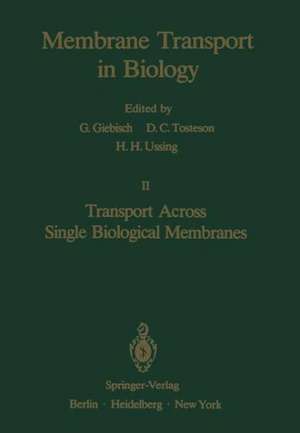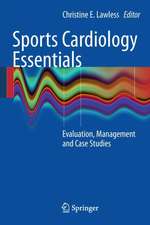Transport Across Single Biological Membranes: Membrane Transport in Biology, cartea 2
Editat de D. C. Tostesonen Limba Engleză Paperback – 23 mar 2012
Preț: 728.89 lei
Preț vechi: 767.26 lei
-5% Nou
Puncte Express: 1093
Preț estimativ în valută:
139.47€ • 145.92$ • 115.86£
139.47€ • 145.92$ • 115.86£
Carte tipărită la comandă
Livrare economică 02-16 aprilie
Preluare comenzi: 021 569.72.76
Specificații
ISBN-13: 9783642463778
ISBN-10: 3642463770
Pagini: 472
Ilustrații: XX, 446 p.
Dimensiuni: 170 x 244 x 25 mm
Greutate: 0.74 kg
Ediția:Softcover reprint of the original 1st ed. 1979
Editura: Springer Berlin, Heidelberg
Colecția Springer
Seria Membrane Transport in Biology
Locul publicării:Berlin, Heidelberg, Germany
ISBN-10: 3642463770
Pagini: 472
Ilustrații: XX, 446 p.
Dimensiuni: 170 x 244 x 25 mm
Greutate: 0.74 kg
Ediția:Softcover reprint of the original 1st ed. 1979
Editura: Springer Berlin, Heidelberg
Colecția Springer
Seria Membrane Transport in Biology
Locul publicării:Berlin, Heidelberg, Germany
Public țintă
ResearchCuprins
1 — Transport of Water and Nonelectrolytes Across Red Cell Membranes.- A. Introduction.- B. Osmotic Equilibria.- C. Methods for Permeability Measurements.- D. Kinetics of Osmotically Induced Volume Changes.- E. Water Permeability.- F. Nonelectrolyte Permeability.- G. Water-Solute Flow Interactions.- Acknowledgements.- References.- 2 — Transport of Anions Across Red Cell Membranes.- A. Introduction.- B. The Fixed-Charge Model.- C. The Concentration Dependence of Anion Fluxes.- D. Temperature Dependence of Anion Exchange.- E. Inhibitors of Anion Exchange.- F. The Titratable Carrier: New Evidence.- G. The Relationship Between the Net Pathway and the Exchange Pathway for Anions in Red Blood Cells.- H. Membrane Structure and Biochemistry Related to Anion Transport.- References.- 3 — Passive Cation Fluxes in Red Cell Membranes.- A. Introduction.- B. The Passive Fluxes of Na+and K+in Red Cell Membranes.- C. A Unified View of Na+ and K+ Transport in Red Cells.- D. A Ca++ -Sensitive K+-Permeability Mechanism in the Red Cell Membrane.- Acknowledgements.- References.- 4 — Active Cation Transport in Human Red Cells.- A. Introduction.- B. Active Na+-K+ Transport in Human Red Cells.- C. Active Ca++Transport in Human Red Cells.- References.- 5 — Transport Across Axon Membranes.- A. Introduction.- B. Methods for Transport Studies.- C. Transport During Bioelectric Activity.- D. Active Transport.- References.- 6 — Ionic Movements Across the Plasma Membrane of Skeletal Muscle Fibers.- A. Introduction.- B. Sodium Movements.- C. Potassium Movements.- D. Chloride Movements.- E. List of Symbols.- Acknowledgements.- References.- 7 — Transport Across Mitochondrial Membranes.- A. Introduction.- B. Mitochondrial Structure, Function and Transport.- C. H+ Transport.- D. MonovalentCation Transport.- E. Transport of Ca++ and Other Divalent Cations.- F. Transport of Anion and Metabolites.- G. Transport of Adenine Nucleotides.- References.- 8 — Transport Across Sarcoplasmic Reticulum in Skeletal and Cardiac Muscle.- A. Introduction.- B. Methods of Preparation.- C. Composition of the SR Membrane.- D. Structural Organization of the SR Membrane.- E. Ca2+ Binding and Ca2+ Transport.- F. Mechanisms of ATP Hydrolysis.- G. Ca2+ Release.- H. Experiments on Reconstitution.- J. Activity of Cardiac Microsomes.- K. Conclusions.- Acknowledgements.- References.- 9 — Transport Across the Lysosomal Membrane.- A. Introduction.- B. The Internal pH of the Lysosome.- C. Mechanisms of Accumulation of Protons in Lysosomes.- D. An ATP-Dependent Proton Pump.- E. The Accumulation of Cationic Dyes and Drugs by Lysosomes.- F. The Permeability of Lysosomal Membranes to Solutes.- References.- 10 — Transport Across Chloroplast Envelopes — The Role of Phosphate.- A. Introduction.- B. The Experimental Basis of Transport Theory.- C. Induction, Autocatalysis, and Orthophosphate.- D. The Phosphate Translocator.- E. Orthophosphate and Pyrophosphate.- F. Control of Photosynthesis by Phosphate Transport.- G. Manipulation of Cytoplasmic Orthophosphate.- H. Orthophosphate and Whole-Plant Physiology.- J. Conclusions.- Acknowledgements.- References.

















